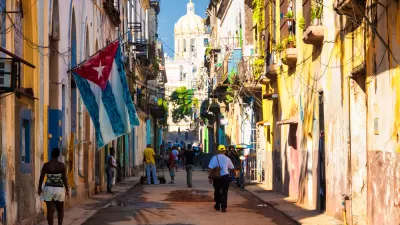The Project for Public Spaces celebrates its 40th anniversary this year, spanning a seismic shift from modernist planning and urban decay of the 1970s to the urban resurgence and focus on smart growth of today. PPS's Ethan Kent reflects.

The Project for Public Spaces, one of the country's leading advocates for placemaking and revitalization of public spaces, was founded in the depths of urban decay in 1975. At the time, big projects and top-down planning held sway. Inspired by Jane Jacobs, founder Fred Kent advocated for many of the urban innovations that are commonplace today.
His son Ethan continues that work, contending that, for all its changes, contemporary policymaking still has not embraced placemaking as a core principle.
One of the challenges lies in the amorphous definition of "place." Even if "place" is important, if policymakers and planners cannot define it, they often have trouble promoting it. In a Q&A for Policy Innovations, Kent said:
"A place is how we are attached to our community, how we experience our world and our community. It's really the patterns of social activity, the cultural openness, commercial and cultural relationships that make a place. There is no formal discipline that is really delivering "place." Just having a space be public space alone isn't often giving value to places, and design is only a small part of what makes a place work."
That's changing with a "place capital metric" being used in Adelaide, Australia, and promoted by PPS. "We measure how businesses are doing, how many people are using the spaces, stationary activity, whether people are gathering in groups, whether there are enough women, children, and elderly in the public space, etc.," said Kent.
Then again, there are even more ambiguous ways to evaluate cities—not by amenities and attractiveness but by the emotional connection between cities and their inhabitants:
"The livability or quality of life lists [that are published every year] look at cities that best balance economic competitiveness and leisure activity, which are the most expensive cities in the world....I think is more about loveabilty, attachment and comfort; and those qualities can occur in some of the poorest parts of the world too."
FULL STORY: What Makes a City Great? It’s not the Liveability but the Loveability

Planetizen Federal Action Tracker
A weekly monitor of how Trump’s orders and actions are impacting planners and planning in America.

Congressman Proposes Bill to Rename DC Metro “Trump Train”
The Make Autorail Great Again Act would withhold federal funding to the system until the Washington Metropolitan Area Transit Authority (WMATA), rebrands as the Washington Metropolitan Authority for Greater Access (WMAGA).

DARTSpace Platform Streamlines Dallas TOD Application Process
The Dallas transit agency hopes a shorter permitting timeline will boost transit-oriented development around rail stations.

Renters Now Outnumber Homeowners in Over 200 US Suburbs
High housing costs in city centers and the new-found flexibility offered by remote work are pushing more renters to suburban areas.

The Tiny, Adorable $7,000 Car Turning Japan Onto EVs
The single seat Mibot charges from a regular plug as quickly as an iPad, and is about half the price of an average EV.

Supreme Court Ruling in Pipeline Case Guts Federal Environmental Law
The decision limits the scope of a federal law that mandates extensive environmental impact reviews of energy, infrastructure, and transportation projects.
Urban Design for Planners 1: Software Tools
This six-course series explores essential urban design concepts using open source software and equips planners with the tools they need to participate fully in the urban design process.
Planning for Universal Design
Learn the tools for implementing Universal Design in planning regulations.
Municipality of Princeton
Roanoke Valley-Alleghany Regional Commission
City of Mt Shasta
City of Camden Redevelopment Agency
City of Astoria
Transportation Research & Education Center (TREC) at Portland State University
US High Speed Rail Association
City of Camden Redevelopment Agency
Municipality of Princeton (NJ)




























